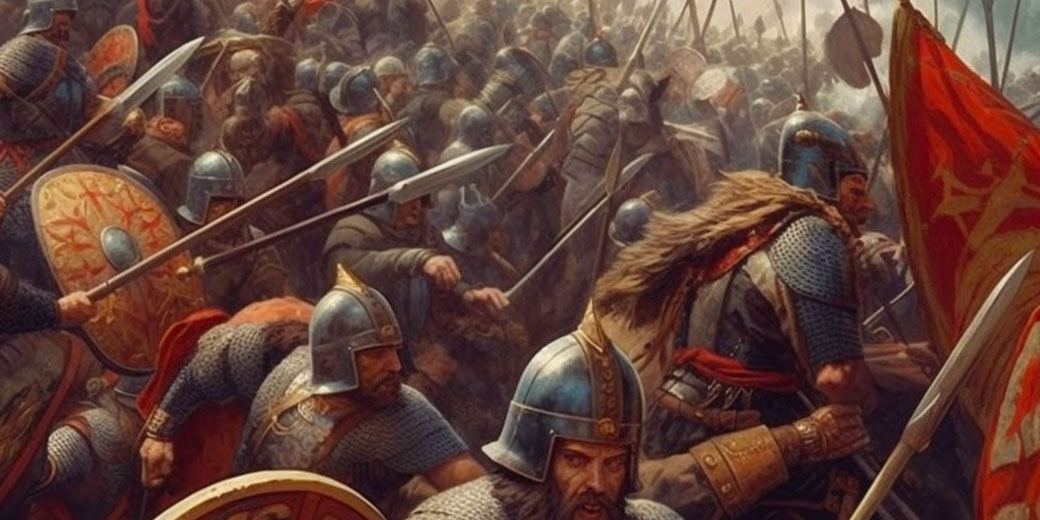The disastrous Battle of Adrianople: The beginning of the end for the Roman Empire

On 9 August AD 378, one of the worst defeats in Roman military history happened on the plains outside the city of Adrianople, in present-day Edirne, Turkey.
What started as an attempt to take control of displaced Gothic migrants turned into a disaster. The death of Emperor Valens and the loss of a large part of the Eastern Roman army showed deep weaknesses in the empire.
It did not cause Rome to fall straight away, but it showed the limits of Roman strength and began a shift that would be hard to undo in the centuries that followed.
An empire in crisis
The causes of the conflict went back to AD 376, when thousands of Gothic refugees, mostly Tervings and Greuthungs escaping the Huns, reached the Danube River looking for safety within the Eastern Roman Empire.
Emperor Valens, who wanted to gain more soldiers for his army and appear as a kind ruler, gave the Goths permission to cross into Roman lands.
In theory, both sides would benefit: the Goths would settle as loyal foederati, and the Romans would get new soldiers.
In reality, the plan quickly fell apart. Dishonest Roman officials took advantage of the Goths, kept back supplies, and increased tensions.
Hunger spread among the refugees, leading to raids. By AD 377, the Goths had started fighting, and the Danube border fell into chaos.
As the Gothic uprising grew, Valens faced two problems. He was blamed for badly handling the refugee crisis and worried about being outshone by his western co-ruler and nephew, Emperor Gratian, who had beaten Germanic tribes in Gaul.
He decided to defeat the Goths before Gratian could step in. To do this, he ignored his generals’ advice and guessed wrongly about the enemy’s strength, and rejected offers from the Gothic leader Fritigern, who may have used peace talks to delay while his cavalry returned.

How the Battle of Adrianople unfolded
The battle happened during the summer heat. Valens led between 15,000 and 25,000 soldiers, mainly from the eastern legions and supporting units.
Fritigern, on the other hand, had a force of unknown size, perhaps smaller or similar, but one that was more flexible because it included fast-moving cavalry.
His group was joined by wagons carrying families and supplies. He delayed the battle by sending messengers to talk, which bought time for his horsemen to return after they had gone to search for food.
Valens, thinking the enemy was in disarray, attacked without waiting for Gratian’s support. This was a fatal mistake.
Roman troops moved forward in the afternoon, under the strain of the August heat.
The Gothic warriors stayed behind a wall of wagons, which drew the Romans into a long and uneven fight.
At the worst moment, Gothic cavalry hit from the sides. The Roman line collapsed.
What came next was a massacre. Entire groups were trapped and wiped out.
Ammianus Marcellinus, a Roman writer, claimed that up to two-thirds of the Roman army died.
Valens himself was killed in the chaos. His body was never found, though some reports said he was burned alive in a farmhouse where he had hidden.
The panicked fall-out from the battle
The short-term results were serious. The Eastern Roman Empire had lost an army and its emperor, which became a model for later agreements.
The Goths moved freely through the Balkans for years, robbing and destroying Roman towns.
The shock of Adrianople also hurt Roman pride. The idea that Roman armies could no longer guarantee victory challenged a long-held belief in Roman strength.
Also, the battle showed the growing danger of relying on foreign groups within Roman borders without proper control.
The empire could no longer easily take in or rule outside peoples as it once had.
In the long run, Adrianople was a key moment in Roman history. The Eastern Empire did regain some order under Theodosius I, who made a deal with the Goths in AD 382, but this deal admitted the limits of Roman power.
The Goths were allowed to live in Thrace under their own leaders while giving troops to the Roman army, but they kept their independence and were not fully brought into Roman society. This became a model for later agreements.
In the west, things became even worse. Within a few decades, these kinds of policies fell apart, ending in the sack of Rome by Alaric’s Visigoths in AD 410—a disaster caused by political chaos, unpaid Gothic soldiers, and broken talks.
The Battle of Adrianople showed that Rome could no longer control its own safety. Power had shifted.
By letting the Goths in and failing to manage their settlement properly, the Romans started a chain of losses, deals, and invasions.
Adrianople did not destroy the empire, but it showed that its base was no longer solid.
From then on, Rome had to react to problems instead of leading, trying to deal with a world it no longer controlled.
What do you need help with?
Download ready-to-use digital learning resources
Copyright © History Skills 2014-2025.
Contact via email
With the exception of links to external sites, some historical sources and extracts from specific publications, all content on this website is copyrighted by History Skills. This content may not be copied, republished or redistributed without written permission from the website creator. Please use the Contact page to obtain relevant permission.





